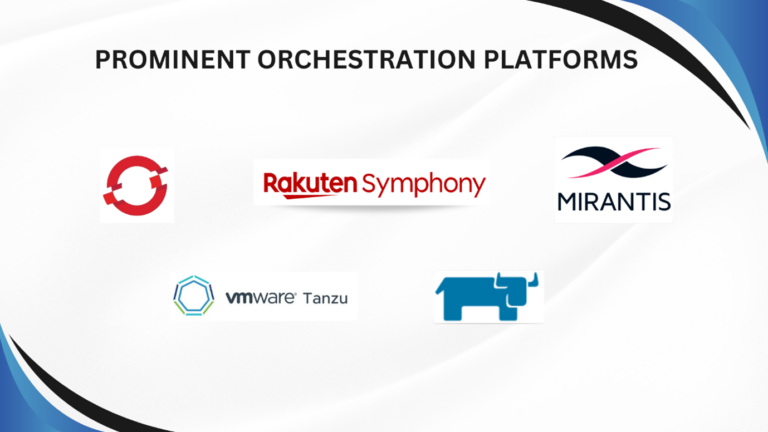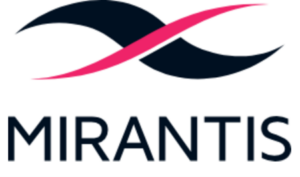Navigating Leading Orchestration Platforms
Red Hat OpenShift, VMware Tanzu, Rakuten CNP, Rancher, and Mirantis Kubernetes Engines

In the dynamic landscape of IT infrastructure, orchestration platforms play a crucial role in managing containerized applications, automating deployments, and streamlining operations. This blog delves into five prominent orchestration platforms: Red Hat OpenShift, VMware Tanzu, Rakuten CNP, Rancher, and Mirantis Kubernetes Engine. Each platform brings unique capabilities to the table, helping organizations optimize their IT operations and achieve greater agility.

Red Hat OpenShift
Red Hat OpenShift by Red Hat is a robust, Kubernetes-based container orchestration platform that extends Kubernetes' capabilities to provide a developer-friendly and secure environment. It offers a comprehensive suite of tools for developers and operators, making it easier to build, deploy, and manage applications in a containerized environment.
Key Features:
- Kubernetes Foundation: Built on Kubernetes, Red Hat OpenShift ensures high scalability, reliability, and seamless container orchestration. It includes all the core Kubernetes components but extends them with additional features and tools.
- Integrated Developer Tools: Includes CI/CD pipelines, integrated development environments (IDEs), and monitoring tools to enhance developer productivity. Red Hat OpenShift also supports various programming languages and frameworks, enabling developers to work in their preferred environments.
- Security and Compliance: Implements robust security measures, including role-based access control (RBAC), automated policy enforcement, and integrated security scans. Red Hat OpenShift’s S2I (Source-to-Image) capability automates the building of reproducible container images, ensuring secure and consistent application deployment.
- Red Hat OpenShift Service Mesh: Provides a dedicated infrastructure layer for microservices, facilitating easier management of complex service interactions, security policies, and observability.
- Operators Framework: Leverages Kubernetes Operators to automate complex application deployment and lifecycle management tasks, ensuring higher availability and reduced operational overhead.
Red Hat OpenShift is ideal for organizations seeking a secure, scalable, and developer-friendly platform for managing containerized applications. It is particularly useful for enterprises looking to implement DevOps practices and improve their continuous integration and delivery pipelines.

VMware Tanzu
VMware Tanzu is a suite of products designed to build, run, and manage modern applications on any cloud. It leverages Kubernetes to provide a consistent, enterprise-grade platform for container orchestration, offering a comprehensive solution for cloud-native application development and operations.
Key Features:
- Multi-Cloud Support: Enables seamless deployment and management of applications across multiple cloud environments, including public clouds like AWS, Azure, and Google Cloud, as well as private data centres.
- Comprehensive Toolset: Includes tools for application lifecycle management, monitoring, and security. Tanzu Application Service (formerly Pivotal Cloud Foundry) simplifies the development and deployment of microservices, while Tanzu Mission Control provides a single point of control for managing Kubernetes clusters across environments.
- Integration with VMware Products: Deep integration with VMware’s virtualization and cloud infrastructure products, providing a unified management experience. VMware vSphere with Tanzu allows enterprises to run Kubernetes workloads directly on their existing vSphere infrastructure.
- Service Mesh and Observability: Offers Tanzu Service Mesh for managing service-to-service communications, and Tanzu Observability for real-time monitoring and analytics, ensuring high performance and reliability of applications.
- Application Modernization: Provides tools and frameworks to modernize legacy applications, enabling them to run efficiently in a cloud-native environment. VMware Tanzu Labs offers expert guidance and best practices for application transformation.
VMware Tanzu is well-suited for enterprises looking to modernize their application portfolios and manage workloads across diverse cloud environments. Its robust feature set and deep integration with existing VMware products make it a powerful choice for enterprises aiming to accelerate their digital transformation.

Rakuten CNP
Rakuten CNP focuses on application automation and data management on Kubernetes. It is designed to simplify the deployment and management of complex, data-intensive applications, making it an ideal platform for enterprises handling stateful applications.
Key Features:
- Application Automation: Automates the deployment, scaling, and lifecycle management of applications on Kubernetes. Rakuten CNP simplifies complex workflows, enabling rapid application delivery and reducing time to market.
- Data Management: Provides advanced data management capabilities, including persistent storage, data replication, and backup. It’s application-aware infrastructure ensures that data is always available and consistent, regardless of where applications are deployed.
- Performance Optimization: Ensures high performance for stateful applications through intelligent resource management and optimization. It dynamically allocates resources based on application needs, ensuring optimal performance and efficiency.
- Simplified Operations: Offers a user-friendly interface for managing Kubernetes clusters and applications, reducing the complexity of Kubernetes operations. Its self-service portal empowers developers and operators to manage their applications independently.
- Multi-Tenancy: Supports multi-tenancy, allowing different teams or departments to use the same infrastructure while maintaining isolation and security. It’s role-based access control (RBAC) ensures secure and controlled access to resources.
Rakuten CNP is perfect for businesses dealing with large-scale, stateful applications that require robust data management and high performance. It is particularly beneficial for industries like finance, healthcare, and telecommunications, where data integrity and performance are critical.

Rancher
Rancher is an open-source platform for managing Kubernetes clusters. It offers a centralized interface for deploying, operating, and securing Kubernetes clusters across any infrastructure, providing a unified approach to container management.
Key Features:
- Multi-Cluster Management: Simplifies the management of multiple Kubernetes clusters from a single pane of glass. Rancher supports on-premises, cloud, and hybrid environments, enabling seamless management of diverse infrastructure.
- User and Access Management: Provides detailed role-based access control (RBAC) and user management capabilities, ensuring secure access to resources. Rancher’s authentication and authorization mechanisms integrate with various identity providers, enhancing security.
- Extensibility: Supports various Kubernetes distributions and cloud providers, allowing for flexible and scalable deployments. Rancher’s catalog includes a wide range of pre-configured applications and services, enabling quick and easy deployment.
- Rancher Continuous Delivery: Facilitates continuous delivery of applications across multiple clusters, ensuring consistent and reliable deployments. Rancher’s GitOps-based approach streamlines application updates and rollbacks.
Rancher is ideal for organizations that need to efficiently manage multiple Kubernetes clusters across different environments. Its user-friendly interface and robust feature set make it an excellent choice for both small and large enterprises looking to streamline their Kubernetes operations.

Mirantis Kubernetes Engine (MKE)
Mirantis Kubernetes Engine (MKE) is an enterprise-level platform designed for deploying and managing containerized applications. It supports both Kubernetes and Docker Swarm. It aims to simplify the deployment and operation of cloud-native applications and infrastructure by its integrated tools and user-friendly interfaces making it an efficient solution for modernizing IT infrastructure.
Key Features:
- Flexibility: MKE supports both Kubernetes and Docker Swarm, allowing it to run on bare metal, private, and public clouds. This versatility ensures that organizations can choose the environment that best fits their needs without being locked into a single provider.
- Ease of Use: The platform offers multiple interfaces, including an API, CLI, and web UI, for managing clusters. This makes it accessible for both novice users and experienced operators, facilitating smooth and efficient cluster management.
- Security: MKE incorporates robust security measures such as role-based access control (RBAC), ensuring that only authorized users can access specific resources. Additionally, it integrates with existing identity management solutions, providing a seamless security framework.
- Integrated Tools: Out-of-the-box, MKE includes Calico for networking and NGINX for ingress management. These integrated tools streamline operations by reducing the need for additional third-party software, thereby simplifying the deployment process.
- Scalability: Designed to handle large-scale deployments, MKE can efficiently scale up to meet the growing needs of an enterprise. This scalability ensures that the platform can grow alongside the business, supporting an increasing number of applications and workloads.
Mirantis is ideal for enterprises seeking open-source solutions for their cloud infrastructure, providing flexibility and control over their deployments. Its strong support makes it a versatile choice for organizations looking to build hybrid or multi-cloud environments.
Conclusion
Each orchestration platform – Red Hat OpenShift, VMware Tanzu, Rakuten CNP, Rancher, and Mirantis Kubernetes Engine (MKE) – offers unique features tailored to different aspects of modern IT infrastructure. Whether your organization aims to enhance developer productivity with Red Hat OpenShift, leverage multi-cloud capabilities with VMware Tanzu, manage data-intensive applications with Rakuten CNP, streamline multi-cluster management with Rancher, or adopt open-source cloud solutions with Mirantis, there is a platform designed to meet your needs. Understanding the distinct advantages of each platform can help your organization make informed decisions to optimize IT operations and drive innovation.
By: Amanpreet Singh Bhogal